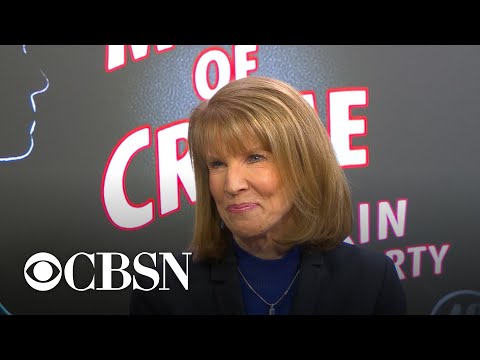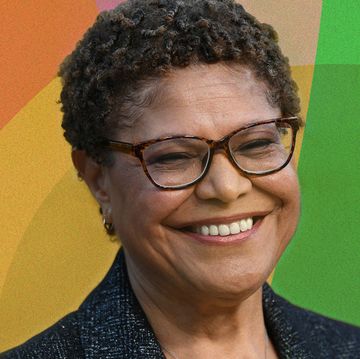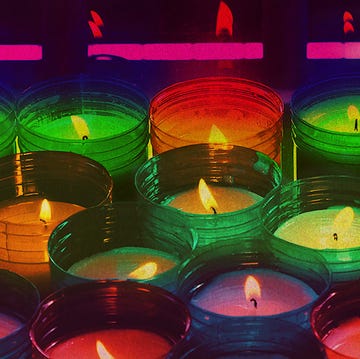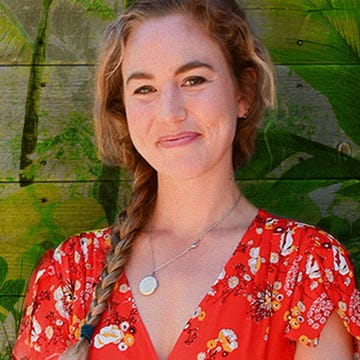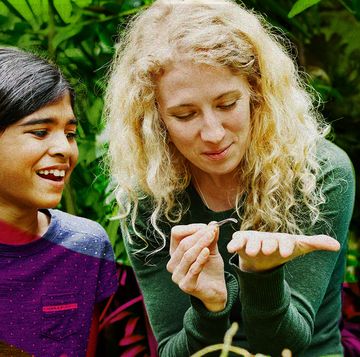As a kid, Erin Moriarty was a big talker and reader, getting in trouble at school because she “couldn’t shut up.”
She tells Shondaland, “That has not changed.” Today, Moriarty is one of the top crime reporters in the United States. Moriarty, who got her start as a lawyer, has now been at CBS for three decades. She’s been a correspondent on 48 Hours (which celebrates its 35th anniversary on January 19) since 1990 and also hosts the true-crime podcast My Life of Crime, now in its third season. (She once formed a “detective agency,” which she says was something of a “precursor for my life.”)
Moriarty, a nine-time Emmy winner, has covered everything from the Iraq War to the JonBenét Ramsey case but is best known as a pro at reporting unsolved crimes. And in many cases, for getting wrongful convictions reversed.
Here’s how Moriarty has sustained a career over the long haul.
Inspired by Perry Mason
Moriarty, who grew up in Columbus, Ohio, always wanted to be a lawyer — and credits Perry Mason for that desire. Many women of her generation, like Elena Kagan, were also inspired by Perry Mason, who, she says, “made the legal profession so glamorous.”
In law school, Moriarty considered herself part of the “third class of ‘normal’ women in law school.” Previously, she says, women in law were “brilliant women who applied against all odds.” In her class, “women applied kind of for the same reason that the guys did — like, we’re interested in the law.”
The reality, however, was a disappointment. “Sadly, Elena and every other woman from my generation realized that reality was much tougher than what it seemed on TV,” she says. “We should have known — there were no female lawyers.”
Her law firm treated her well, Moriarty says, but the surrounding environment did not. The Columbus Club, for instance — a place where lawyers would take clients — didn’t allow women. “And judges would talk down to you in the courtroom and call you honey,” she remembers. “They didn’t want you there.”
The transition to television
The move from law to TV was “so much fun,” Moriarty recalls. Instead of spending years on a case, she could do a story in a week or two. Yet the stigma continued.
When she entered television, “people from my law class said I ‘wasted a space’ — that I took a space away from a man and wasn’t even practicing law. That was the attitude in the late ’70s and ’80s,” she says.
“It was normal to hear it,” she continues. “But my attitude was ‘Well, that’s because you guys took all the seats to begin with.’” She remained undeterred. “When you meet lawyers of my generation, we’re all a bunch of pretty self-confident human beings.”
In fact, the negative talk may have worked to her advantage, Moriarty says. Subjects would often open up to her as a journalist in interviews more than they would when she was in her role as a lawyer.
On doubt and insecurity
In the TV business, you move around a lot, Moriarty says. This has meant, in her career, “a lot of lonely times and insecure times,” she explains. Moriarty says she “survived” living and working in Chicago, and when she moved to New York City, with a 2-year-old, she had “a little more confidence.”
Moriarty describes several moments of doubt in her career. And sometimes, for good reason — she was close to getting fired from a job she held in Baltimore, for instance. But looking back, she would have “told my younger self not to worry quite as much,” she says.
Even though she didn’t go to school for journalism and had a big learning curve, she was able to become successful. “Have faith that you are going to make it,” she advises younger job seekers, “or know that there are other options if you don’t.”
A new world of legal journalism
She believes she got into legal reporting at the perfect time. The O.J. Simpson trial in 1994 really changed the game, Moriarty says, by using DNA in a legal case. “Those of us who covered the trial were forced to start learning how it operated and what it did,” she recalls.
“The idea was that DNA could point to a guilty person,” Moriarty says. “But for me, it pointed out how often the system failed.”
This case opened the floodgates, and all of a sudden, Moriarty could use her legal background to report on tons of cases that “people who weren’t lawyers weren’t looking at,” such as wrongful convictions and other cases where the “system failed,” she says. DNA was used not just to convict but also to exonerate the accused, she says, leading to investigations about what was behind the conviction in the first place, such as bad eyewitness testimony and forced confessions.
Staying close to sources
After the story is finished, it doesn’t necessarily end for Moriarty. She says she often reports on cases that “involve terrible tragedy and pain” and becomes invested in the outcome.
Despite “many levels of emotional difficulty” that victims and victims’ families may be going through, even in the case of a conviction, Moriarty says she chooses to focus on the “heroic characters” — the way that those who have suffered tragedies are able to survive.
“How can they not be bitter and angry?” Moriarty posits. “I don’t know, but they never are. I find comfort in that.”
She adds, “I never lose touch.” She stayed in touch with families of the victims of the 1991 yogurt shop murders — four young women who were killed, an unsolved case. “I think about their parents all the time,” she says. “I have a son. I can’t even imagine losing your children and not having the case solved.”
Moriarty loses sleep over unsolved cases. And she doesn’t necessarily believe in a work-life balance.
“I know most people say the best advice for people is a life-work balance,” she says. “I don’t totally agree with that. I’m not saying that work should be everything, and you certainly shouldn’t, you know, do anything to keep a job — that’s not worth it. But I can’t imagine a life where work wasn’t a part of my life.”
Women helping women
Moriarty says there are still “immense barriers” facing women in law and journalism. And she hears from many women of color who she says “are still encountering some of the same barriers” that white women faced decades ago. It’s harder to become a partner, for instance, or to get new clients.
Unequal pay is still a real thing, she contends. “Women are getting paid less, but nobody talks about it,” she says. “So, we don’t know.”
And there’s what she used to call “the pink ghetto. You know, all the producers who were doing all the work were women,” she says. “That still exists.”
Still, Moriarty is in awe of women from the younger generation, in their 20s and 30s specifically, and what they won’t put up with.
She once heard Nina Totenberg, a law reporter at NPR, speak with reporter Cokie Roberts and another reporter who made a concerted effort to help younger women in their field. “That’s one thing I wish we saw more of,” Moriarty said. “Women from my generation and the next group coming up, reaching a hand out — to be there when [younger women] run into whatever kinds of problems. We should be looking out for other women more than we do.”
Moriarty had mentors, but they were men. Eric Ober and Andrew Heyward, for instance, former presidents of CBS, “wanted to see women succeed and pushed me,” she remembers.
“Let’s be honest,” says Moriarty. “A generation ago, a woman my age was not on television. I just signed a three-year contract — and that says more about CBS, I think, than it does about me.”
Hope Reese is a freelance journalist whose work has been featured in The New York Times, Vox, and The Atlantic. Follow her on Twitter @hope_reese.


